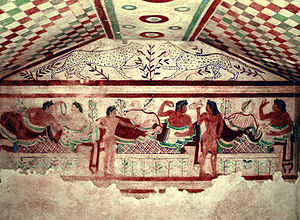Corneto Tarquinia
| Tarquinia | ||
|---|---|---|
| Comune | ||
| Comune di Tarquinia | ||

Tarquinia's town square with the city hall (Palazzo Comunale) on the right.
|
||
|
||
| Location of Tarquinia in Italy | ||
| Coordinates: 42°14′57″N 11°45′22″E / 42.24917°N 11.75611°ECoordinates: 42°14′57″N 11°45′22″E / 42.24917°N 11.75611°E | ||
| Country | Italy | |
| Region | Lazio | |
| Province / Metropolitan city | Viterbo (VT) | |
| Frazioni | Tarquinia Lido | |
| Government | ||
| • Mayor | Mauro Mazzola (PD) | |
| Area | ||
| • Total | 279.50 km2 (107.92 sq mi) | |
| Elevation | 132 m (433 ft) | |
| Population (May 2010) | ||
| • Total | 16,630 | |
| • Density | 59/km2 (150/sq mi) | |
| Demonym(s) | Tarquiniesi | |
| Time zone | CET (UTC+1) | |
| • Summer (DST) | CEST (UTC+2) | |
| Website | Official website | |
 |
|
| UNESCO World Heritage Site | |
|---|---|
| Official name | Etruscan Necropolises of Cerveteri and Tarquinia |
| Location |
Viterbo Province, Italy |
| Coordinates | 42°14′57″N 11°45′22″E / 42.2492°N 11.7561°E |
| Area | 279.34 km2 (3.0068×109 sq ft) |
| Criteria | Cultural: i, iii, iv |
| Reference | 1158 |
| Inscription | 2004 (28th Session) |
| Website | www |
|
[]
|
|
Tarquinia (Italian: [tarˈkwiːnja]), formerly Corneto, is an old city in the province of Viterbo, Lazio, Italy known chiefly for its outstanding and unique ancient Etruscan tombs in the widespread necropoli or cemeteries which it overlies, for which it was awarded UNESCO World Heritage status.
In 1922 it was renamed after the ancient city of Tarquinii (Roman) or Tarch(u)na (Etruscan). Although little is visible of the once great wealth and extent of the ancient city, archaeology is increasingly revealing glimpses of past glories.
The Etruscan and Roman city is situated on the long plateau of La Civita to the north of the current town.
The ancient burial grounds (necropoli), dating from the Iron Age (9th century BC, or Villanovan period) to Roman times, were on the adjacent promontories including that of today's Tarquinia.
Tarquinii (Etruscan Tarch(u)na etc.) was one of the most ancient and important Etruscan cities; the ancient myths connected with Tarchuna (those of its eponymous founder Tarchon - the son or brother of Tyrrhenos - and of the infant oracle Tages, who gave the Etruscans the "disciplina etrusca"), all point to the great antiquity and cultural importance of the city; and the archaeological finds bear out that Tarchuna was one of the oldest Etruscan centres which eclipsed its neighbours well before the advent of written records. It is said to have been already a flourishing city when Demaratus of Corinth brought in Greek workmen.
Descendants of Demaratus, Lucius Tarquinius Priscus and Lucius Tarquinius Superbus, became kings of ancient Rome. From Tarchuna many of the religious rites and ceremonies of Rome are said to have been derived, and even in imperial times a collegium of sixty haruspices continued to exist there.
...
Wikipedia



